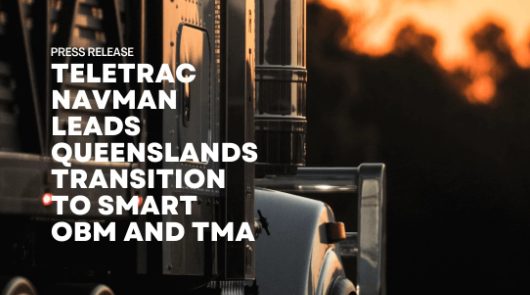Global telematics specialist Teletrac Navman will assist transport operators across Queensland transition to new and improved Smart On-Board Mass (Smart OBM) and Telematics Monitoring Application (TMA).
Giving Queensland operators the opportunity to be more productive and efficient, Smart OBM monitors the mass of a vehicle combination’s axle groups, while TMA records important positional information, which in an aggregated form can provide valuable insights on truck movements.
Smart OBM and TMA are critical tools for the Department of Transport and Main Roads (TMR) as a way to provide assurance around heavy vehicle access to the state road network.
Jurisdictions across Australia are moving to Smart OBM and TMA, with NSW and Victoria already using the technology.
Starting from 1 December 2022, Class 2 heavy vehicles currently operating under Queensland Interim OBM and Higher Mass Limits (HML) in the Intelligent Access Program (IAP) will be required to transition to Smart OBM and TMA.
“Thirteen years ago, Teletrac Navman began championing the Intelligent Access Program (IAP), a national program developed in partnership with all Australian road agencies. Through this program, many Australian customers have been able to increase productivity. The new Smart OBM and TMA technology enable a greater ROI thanks to the lower cost of the tech set-up and additional requirements,” explains Teletrac Navman’s National Manager, Transport, Anthony Laras.
“Transport operators will see the long-term benefits because governments will be able to fix the roads that need to be fixed, which can’t be done without good data,” he said.
“It’s a change for the greater good that will allow Australia’s network of access for heavy vehicles to be connected.
“At a time when Australia is facing multiple threats to our supply chain, with staff shortages, floods and storms destroying crops and roads, and the ever-rising cost of fuel, an opportunity to save costs by enabling a safer, faster solution is a win for us all.”
What it means for operators
The transition to Smart OBM and TMA is a crucial step towards national harmonisation and cross-border efficiencies, with NSW and Victoria already using this technology.
It will also deliver potential cost savings and operational efficiencies to the industry.
“If we can give transport operators the ability to move more with less, that truck is suddenly generating more revenue by saving on fuel, driver hours and maintenance costs. It means fewer trips for drivers, fewer truck movements, less CO2 emissions, less tyre wear and tear, more profit, and more safety,” Anthony explains.
With over a million trucks on Australia’s roads, safety is a paramount concern, and Australia’s world-class tech is being noticed on a global stage.
“There’s no other country in the world doing it,” Anthony added. “I had the privilege to address a European Union delegation, who were fascinated with what was happening here. We are miles ahead of anybody on the planet in this space.”
Benefits of Smart OBM and TMA
Smart OBM and TMA are critical road management tools for TMR, providing ongoing access to telematics data. This data is essential to ensure continued heavy vehicle access to the road network under current access arrangements and factors into additional access considerations in the future.
The transition to Smart OBM and TMA will deliver a range of benefits, including:
- Smart OBM scale calibration requirements will align with the manufacturer’s specifications, resulting in a potential change from a 6-monthly to a 12-monthly calibration schedule
- Delivery of a richer telematics data set provides TMR with greater oversight over how heavy vehicles are used on the road network and enables improved future assessment of access to the road network
- In many cases, current In-Vehicle Units (IVU) and OBM scales are already compatible with TMA and Smart OBM
- Often, the operating costs of TMA are less than IAP, resulting in potential cost savings for transport operators
Class 2 vehicles subject to telematic requirements must be fully transitioned to TMA and Smart OBM by 1 June 2024 to continue to operate on state-controlled roads in Queensland.
The changes only apply to Class 2 vehicles that are currently subject to telematic requirements. It will not be mandatory for enrolled Transport Operators to transition to TMA or Smart OBM immediately, as the transition will be phased in over 18 months.
Smart OBM and TMA are Intelligent Transport Systems certified by Transport Certification Australia.



